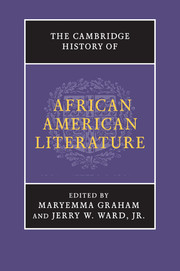Book contents
- Frontmatter
- Introduction
- PART I AFRICAN AMERICAN LITERATURE FROM ITS ORIGINS TO THE TWENTIETH CENTURY
- PART II AFRICAN AMERICAN LITERATURE IN THE TWENTIETH CENTURY
- PART III AFRICAN AMERICAN LITERATURE AS ACADEMIC AND CULTURAL CAPITAL
- 24 Children's and young adult literatures
- 25 From writer to reader: black popular fiction
- 26 Cultural capital and the presence of Africa: Lorraine Hansberry, August Wilson, and the power of black theater
- 27 African American literature: foundational scholarship, criticism, and theory
- 28 African American literatures and New World cultures
- Bibliography
- Index
- References
24 - Children's and young adult literatures
from PART III - AFRICAN AMERICAN LITERATURE AS ACADEMIC AND CULTURAL CAPITAL
Published online by Cambridge University Press: 28 May 2011
- Frontmatter
- Introduction
- PART I AFRICAN AMERICAN LITERATURE FROM ITS ORIGINS TO THE TWENTIETH CENTURY
- PART II AFRICAN AMERICAN LITERATURE IN THE TWENTIETH CENTURY
- PART III AFRICAN AMERICAN LITERATURE AS ACADEMIC AND CULTURAL CAPITAL
- 24 Children's and young adult literatures
- 25 From writer to reader: black popular fiction
- 26 Cultural capital and the presence of Africa: Lorraine Hansberry, August Wilson, and the power of black theater
- 27 African American literature: foundational scholarship, criticism, and theory
- 28 African American literatures and New World cultures
- Bibliography
- Index
- References
Summary
Like African American literature more generally, African American children's literature emerged in response to a number of needs within the American cultural and political context. This chapter examines what those needs were, how they have been met, and to what extent they have changed. This chapter is included in the book first and foremost because of the history that African American children's literature shares with African American literature: (1) recognizing and desiring to address the striking absence or the persistent stereotypes of people of African descent in mainstream literature (works such as Joel Chandler Harris's Uncle Remus tales, Helen Bannerman's The Story of Little Black Sambo [1899], Laura Lee Hope's Bobbsey Twins series, and Hugh Lofting's The Voyages of Dr. Dolittle [1922] provide a few cogent examples); (2) the longstanding “ghettoized” experience of the body of work itself within and without the larger field of canonical literature. Many African American writers – among them Langston Hughes, Arna Bontemps, Gwendolyn Brooks, bell hooks, and Toni Morrison – have traversed the boundary between “adult” and “children's” writing, allowing readers to see their most salient ideas and artistry in a variety of contexts. Finally, African American children's literature not only has evolved in its own right, but also has redefined a major component of what is today the largest single industry in the world, publishing and entertainment.
What concerns us in this chapter is the extent to which children's literature – in the categories of both picture books and young adult (YA) literature – can inform our understanding of the development of African American literature.
- Type
- Chapter
- Information
- The Cambridge History of African American Literature , pp. 619 - 654Publisher: Cambridge University PressPrint publication year: 2011
References
- 3
- Cited by

